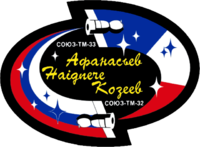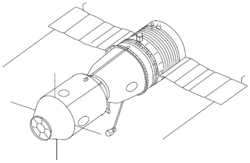Sojuz TM-33
| Sojuz TM-33 (Союз ТM-33) | |||
 | |||
| Beställare | Roskosmos | ||
|---|---|---|---|
| Modell | Sojuz-TM | ||
| Tillverkare | RKK Energia | ||
| Operatör | Roskosmos | ||
| Färdens tid | 195 dagar 18 tim 52 min 18 sek | ||
| NSSDC-ID | 2001-048A[1] | ||
| Uppskjutning | |||
| Startplats | Bajkonur LC1 | ||
| Start | 21 oktober 2001, 08:59:35 UTC | ||
| Raket | Sojuz-U | ||
| Landning | |||
| Landningsplats | 26 km SO om Arkalyk, Kazakstan | ||
| Landning | 5 maj 2002, 03:51:53 UTC | ||
| Omloppsbana | |||
| Varv | 3 195 st[2] | ||
| Apogeum | 227 km | ||
| Perigeum | 191 km | ||
| Banlutning | 51,7° | ||
| Besättning | |||
| Start | Viktor Afanasjev Claudie Haigneré Konstantin Kozejev | ||
| Landning | Jurij Gidzenko Roberto Vittori Mark Shuttleworth | ||
 Från vänster: Kozejev, Afanasjev, Haigneré | |||
| Dockning | |||
| Rymdstation | ISS | ||
| Dockning | 23 oktober 2001, 10:44:15 UTC | ||
| Port | Zarja, nadir | ||
| Ur dockning | 20 april 2002, 09:15:40 UTC | ||
| Andra Dockning | 20 april 2002, 09:37:14 UTC | ||
| Port | Pirs, nadir | ||
| Andra ur dockning | 5 maj 2002, 00:31:08 UTC | ||
| Kronologi | |||
| |||
Sojuz TM-33 (ryska: Союз ТM-33) var en flygning i det ryska rymdprogrammet. Flygningen gick till Internationella rymdstationen. Farkosten sköts upp med en Sojuz-U-raket från Kosmodromen i Bajkonur den 21 oktober 2001. Den dockade med rymdstationen den 23 oktober 2001. Den 20 april 2002 flyttades farkosten från nadirporten på Zarjamodulen till nadirporten på Pirs-modulen. Farkosten lämnade rymdstationen den 5 maj 2002. Några timmar senare återinträdde den i jordens atmosfär och landade i Kazakstan.
Referenser
- ^ ”NASA Space Science Data Coordinated Archive” (på engelska). NASA. https://nssdc.gsfc.nasa.gov/nmc/spacecraft/display.action?id=2001-048A. Läst 29 februari 2020.
- ^ Manned Astronautics - Figures & Facts Arkiverad 4 mars 2016 hämtat från the Wayback Machine., läst 9 oktober 2016.
| |||||||||||||||||||||||||||||||||||||||||||||||||||||||||||||||||||||||||||||||||||||||||
| |||||||||||||||||||||||||||||||
| ||||||||||||||||||||||||||||||||
Media som används på denna webbplats
Färg som används: National flag | South African Government and Pantone Color Picker
| grön | rendered as RGB 0 119 73 | Pantone 3415 C |
| gul | rendered as RGB 255 184 28 | Pantone 1235 C |
| röd | rendered as RGB 224 60 49 | Pantone 179 C |
| blå | rendered as RGB 0 20 137 | Pantone Reflex Blue C |
| vit | rendered as RGB 255 255 255 | |
| svart | rendered as RGB 0 0 0 |
Soyuz-A manned spacecraft concept (1963). It was to have been part of the Soyuz A-B-C circumlunar complex.
Apollo-Soyuz Test Project (ASTP) Soyuz. The APAS-75 docking unit is located at left.
Soyuz-TM spacecraft. Compare the antennas on the orbital module to those on Soyuz-T. Differences reflect the change from the Igla rendezvous system used on Soyuz-T to the Kurs rendezvous system used on Soyuz-TM.
The Soyuz TMA-04M spacecraft is seen after being rolled out by train to the launch pad at the Baikonur Cosmodrome in Kazakhstan, May 13, 2012. The launch of the Soyuz spacecraft, with Expedition 31 Soyuz Commander Gennady Padalka, Flight Engineer Sergei Revin of Russia and NASA Flight Engineer Joe Acaba, is scheduled for 9:01 a.m., May 15 (Kazakhstan time).
Rotated and color enhanced version of original (ISS013-E-48788 (6 July 2006) --- The Space Shuttle Discovery approaches the International Space Station for docking but before the link-up occurred, the orbiter went through a series of inspection photos by station crew to inspect the vehicle for any damage to its Thermal Protection System. This was known as the Rendezvous Pitch Maneuver and was implemented after the Columbia Disaster in 2003. The Leonardo Multipurpose Logistics Module can be seen in the shuttle's cargo bay. Discovery docked at the station's Pressurized Mating Adapter 2 at 9:52 a.m. CDT, July 6, 2006.)
Backdropped by a blue and white Earth, this close-up view features the Soyuz TMA-6 spacecraft approaching the International Space Station (ISS). Onboard the spacecraft are cosmonaut Sergei K. Krikalev, Expedition 11 commander representing Russia's Federal Space Agency; astronaut John L. Phillips, NASA ISS science officer and flight engineer; and European Space Agency (ESA) astronaut Roberto Vittori of Italy. The Soyuz linked to the Pirs Docking Compartment at 9:20 p.m. (CDT) on April 16, 2005 as the two spacecraft flew over eastern Asia. The docking followed Friday’s launch from the Baikonur Cosmodrome in Kazakhstan.
In this illustration, a SpaceX Crew Dragon spacecraft approaches the International Space Station for docking. NASA is partnering with Boeing and SpaceX to build a new generation of human-rated spacecraft capable of taking astronauts to the station and expanding research opportunities in orbit. SpaceX's upcoming Demo-1 flight test is part of NASA’s Commercial Crew Transportation Capability contract with the goal of returning human spaceflight launch capabilities to the United States.
Författare/Upphovsman: Pascal (Flickr user: pasukaru76), Licens: CC0
Vostok spacecraft replica at the Technik Museum Speyer, Germany.
The Soyuz Taxi crewmembers assemble for a group photo in the Zvezda Service Module on the International Space Station (ISS). From the left are Flight Engineer Konstantin Kozeev, Commander Victor Afanasyev, and French Flight Engineer Claudie Haignere. Afanasyev and Kozeev represent Rosaviakosmos, and Haignere represents ESA, carrying out a flight program for CNES, the French Space Agency, under a commercial contract with the Russian Aviation and Space Agency. This image was taken with a digital still camera.
Insignia for the Soyuz TM-34 mission to the International Space Station. In this version: Converted to PNG format, background removed, and other minor optimizations.























